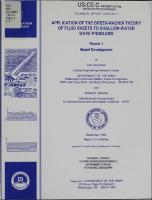Please use this identifier to cite or link to this item:
https://hdl.handle.net/11681/12620Full metadata record
| DC Field | Value | Language |
|---|---|---|
| dc.contributor | University of California, Berkeley | - |
| dc.contributor | Ship Research Inc. | - |
| dc.contributor.author | Demirbilek, Zeki | - |
| dc.contributor.author | Webster, William C. | - |
| dc.date.accessioned | 2016-07-06T14:23:57Z | - |
| dc.date.available | 2016-07-06T14:23:57Z | - |
| dc.date.issued | 1992-09 | - |
| dc.identifier.uri | http://hdl.handle.net/11681/12620 | - |
| dc.description | Technical Report | - |
| dc.description | Abstract: This report presents the mathematical formulation for the development of a numerical model that simulates wave transformation in shallow waters. The model is intended both for military and civil works projects involving propagation of time-dependent and nonlinear waves where existing models may either be inapplicable or use of simple analytic or numerical solutions is infeasible. The theory detailed in this report introduces a new-generation water wave model for shallow to moderate water depths where the seabed varies rapidly. The Green-Naghdi Level II theory, hereafter referred to simply as the GN theory, has been significantly modified in this research and a powerful, general-purpose numerical model, called GNWave, is developed for water wave problems. The theory and ensuing model incorporate some of the most important mathematical features of the water wave equations. These include non-approximating of the governing Euler's field equations and imposing the proper boundary conditions necessary for capturing the bulk physical characteristics of wave trains in the shallow-water regime. The GN approach, which is fundamentally different from the perturbation method based on developments in classical wave theory begun by Stokes and Boussinesq in the last century, can do this only because it does not introduce any simplifications of the velocity variation in the vertical direction across the fluid layers or sheets. In contrast to the Stokes and Boussinesq theories, the equations of motion in the GN theory are derived by enforcing exact kinematic and dynamic boundary conditions on the free surface and on the bottom, and by enforcing conservation of mass and of the 0th and 1st moments of momentum in the vertical direction. These conditions yield 11 coupled partial differential equations, which can be reduced to 3 complicated governing equations by elimination of many of the variables. In summary, the GN theory is different from the perturbation approach in that the free surface and bottom boundary conditions are met exactly, whereas the field equation is implicitly approximated. The result is a theory that can predict the shape and behavior of waves up to almost breaking conditions. The GN theory breaks down when the particle velocity at the crest equals the wave speed, the criterion for breaking in the exact theory. By developing the unrestricted Green-Naghdi theory of fluid sheets, this research presents a new wave theory consisting of a coupled, nonlinear set of partial differential equations and integrates these in time and space to simulate either regular or irregular real waves. The theory and model have been shown to reproduce with engineering accuracy the evolution of a wave of permanent form, from small amplitudes up to almost breaking conditions. The theory presented is for a nonlinear numerical wave tank in which the seabed topography profile can be arbitrary and very irregular, and up to 20 wave gages can be positioned at will inside the computational domain to obtain snapshots and profiles of wave records. The types of projects to which the theory can be applied are many, and include problems of both military and civil interest. The theory is purposely made to be versatile to permit decision makers, designers, and analysts to assess the various aspects of waves and wave-structure interaction problems arising in Army applications. One can evaluate, for instance, the effect of submerged obstacles during military landings on the train of waves approaching a beach or landing zone, or the reflection of waves and forces on sea walls or spillway hydraulic gates, and the time history of bottom-mounted pressure gage measurements for estimation of surface wave conditions in coastal design projects. The theory is particularly suited for the violent collision of waves with natural and man-made structures, and their impact on preventive and defensive hydraulic structures. | - |
| dc.publisher | Coastal Engineering Research Center (U.S.) | - |
| dc.publisher | Engineer Research and Development Center (U.S.) | - |
| dc.relation | http://acwc.sdp.sirsi.net/client/en_US/search/asset/1032442 | - |
| dc.relation.ispartofseries | Technical report (U.S. Army Engineer Waterways Experiment Station) ; CERC-92-11 rept. 1. | - |
| dc.rights | Approved for public release; distribution is unlimited. | - |
| dc.source | This Digital Resource was created from scans of the Print Resource | - |
| dc.subject | Amphibious/landing operations | - |
| dc.subject | Coastal processes | - |
| dc.subject | Hydraulic structures | - |
| dc.subject | Logistics-over-the-shore (LOTS) | - |
| dc.subject | Numerical simulation | - |
| dc.subject | Water surface profile | - |
| dc.subject | Wave-structure interaction | - |
| dc.subject | Wave theories | - |
| dc.subject | Hydrodynamics | - |
| dc.subject | Ocean waves | - |
| dc.subject | Shallow water | - |
| dc.subject | Nonlinear wave equations | - |
| dc.subject | Mathematical models | - |
| dc.title | Application of the Green-Naghdi theory of fluid sheets to shallow-water wave problems. Report 1, Model development | - |
| dc.type | Report | en_US |
| Appears in Collections: | Technical Report | |
Files in This Item:
| File | Description | Size | Format | |
|---|---|---|---|---|
| TR-CERC-92-11.pdf | 8.08 MB | Adobe PDF |  View/Open |